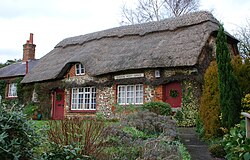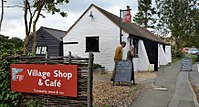Slindon
| Slindon | |
| Sussex | |
|---|---|
 Slindon post office | |
| Location | |
| Grid reference: | SU961084 |
| Location: | 50°52’3"N, 0°38’7"W |
| Data | |
| Population: | 595 (2011) |
| Post town: | Arundel |
| Postcode: | BN18 |
| Dialling code: | 01243 |
| Local Government | |
| Council: | Arun |
| Parliamentary constituency: |
Arundel and South Downs |
Slindon is a mostly rural village in the south-west of Sussex, containing a developed nucleus amid woodland, six miles north-east of Chichester, in the Rape of Chichester in the west of the county.
Much of Slindon's woodland, spread over the southern edge of the escarpment of the South Downs, belongs to the National Trust.
History
The village is listed in the Domesday Book of 1086 as "Eslindone", the name having the probable meaning in Old English of "sloping hill".[1] The Domesday Book records Slindon as having 35 households, putting it in the largest 20% of settlements.[2]
St Mary's 12th-century parish church contains a memorial to Stephen Langton (c1150–1228), the Archbishop of Canterbury who attended the signing of Magna Carta.
In the Middle Ages Slindon House (now Slindon College) was the site of one of the Archbishop's residences. In 1330 Thomas de Natindon, who was a legal representative of the Pope, was sent there to serve a writ on the archbishop. His party were not well received by the archbishop's servants who stripped and bound them, then threw cold water over them, apparently with the archbishop's consent. Natindon escaped revenge and was pursued over the hills to Petworth where he was caught and held in prison for three days.[3]
The village war memorial was unveiled in 1921, with the names of 14 residents killed in First World War; a further three names were added after Second World War.[4]
The writer Hilaire Belloc (1870–1953) lived in the village.
About the village
The old village forge has been converted into a shop, café and information centre; this opened in 2012.[5]
The village has been called the "pumpkin capital of Britain", and an annual display of pumpkins attracts tourists to the village.
A short walk from the village is Nore Folly (also known as Slindon Folly): this was built during the 18th Century by the Newburgh family, whose seat was at Slindon. The Folly resembles a gateway but leads to nowhere.
Outside links
| ("Wikimedia Commons" has material about Slindon) |
References
- ↑ Mills, Anthony David: 'A Dictionary of British Place-Names' (Oxford University Press, 2003) ISBN 978-0-19-852758-9
- ↑ Slindon in the Domesday Book
- ↑ Peter Jerrome, Petworth. From the beginnings to 1660. The Window Press 2002 p31-32
- ↑ National Heritage List 1436576: Slindon War Memorial (Grade II listing)
- ↑ Slindon Forge. "The History & Restoration of Slindon Forge". http://www.slindonforge.com/history/.
